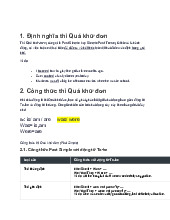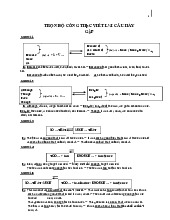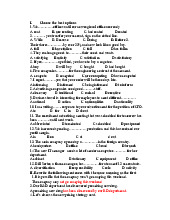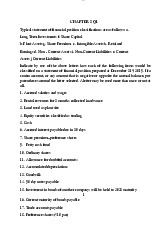


Preview text:
lOMoAR cPSD| 48632119
Portfollio viết 1 đoạn văn tóm tắt bài Unit 10: Price
The unit is about how companies/businesses/producers keep prices down/push down prices.
The unit is about how food companies try to push down their prices.
The article is about a survey on food that becoming cheaper and cheaper.
The article is about how companies push down prices in food/ food industries lower their prices.
Food companies push down prices by using technology/ Food companies try to push down prices, using technology.
What technology do they use?- Food production and distribution technology.
How food production/ distribution technology help companies lower price?
Food producing: We are producing more and more food with less and less capital thanks to
the advance in food producing technology.( It costs less to produce large quantities of food
than ever before, so that consumers can enjoy cheaper food.) Distribution :
The unit is about the importance of prices to companies and customers. Price= costs + profit margin. Writing
Large chain stores and small shops both have their own advantages and disadvantages. Large
chain stores usually offer a wider range of products at lower prices due to their ability to buy
products in bulk. They also tend to have more consistent quality and customer service across
all their locations. On the other hand, small shops often provide a more personalized and
unique shopping experience with more specialized products and a greater sense of
community. However, their prices may be higher due to lower purchasing power and they
may not always have the same level of resources as larger stores.
1. Price is a crucial factor for both companies and consumers. For companies, pricing their
products or services correctly can make the difference between success and failure in the
marketplace. If prices are too high, customers may choose to buy from a competitor, while
prices that are too low can lead to decreased profit margins.
For consumers, price plays a significant role in their purchasing decisions. They are always on
the lookout for the best value for their money and may compare prices across different brands
or retailers before making a purchase. For some consumers, a lower price may be the deciding
factor, while others may be willing to pay more for higher quality or better features.
2. Some ways cheap food makes people unhealthy.
When we eat cheap food, it can harm our health in several ways. Firstly, cheap food is often
highly processed and contains high amounts of sugar, salt, and unhealthy fats. This can lead to
weight gain and health issues like heart disease, diabetes, and high blood pressure. Processed lOMoAR cPSD| 48632119
foods are also often low in essential nutrients that our bodies need to stay healthy. Secondly,
producing cheap food often involves harmful farming practices that can damage the
environment and public health. For example, pesticides and other chemicals used in farming
can pollute the water supply, harm wildlife and human health. Lastly, eating cheap food often
means we lack variety in our diets, which can lead to nutrient deficiencies and other health
problems. It's important to make informed decisions about what we eat and where our food
comes from to avoid long-term health issues. 3. How technology pushes down food prices?
Technology can help push down the price of goods and services in a variety of ways. Firstly,
technological advancements can lead to greater efficiency in production processes, reducing
the time and resources required to produce a product. This can lower manufacturing and labor
costs, which can be passed on to consumers in the form of lower prices. Secondly, technology
can facilitate the development of new production methods or materials that are cheaper and
more sustainable than traditional methods. For example, the use of 3D printing technology
can reduce the costs of producing complex parts and prototypes. Lastly, technology can
enable businesses to reach a wider audience and reduce their marketing and distribution costs.
Online marketplaces and social media platforms, for example, can help businesses reach
customers more easily and at a lower cost than traditional advertising methods. Overall,
technology can play a significant role in reducing the costs of goods and services, making
them more affordable and accessible to consumers.
4. Food is therefore more plentiful and cheaper than it has ever been. Why are there still famines?
It is true that food is more abundant and affordable than ever before, thanks to advances in
agriculture and food production. However, famines still occur due to a variety of factors,
including natural disasters, political instability, poverty, and conflicts. In some cases, food
may be available, but people may not have the means to access it due to a lack of
transportation or infrastructure. Additionally, food waste and unequal distribution of resources
can exacerbate the problem. Addressing these complex issues requires a multi-faceted
approach involving government policies, international aid, and community-based solutions. 5. Summarize
Advances in food production and distribution technology have led to a decrease in food
prices, benefiting consumers. With less capital, food is more plentiful and cheaper than ever,
and spending on food has fallen for many years. Supermarkets have helped push down prices
by investing in efficient IT systems and buying in bulk. Large retail companies like Wal-Mart
can pressure producers to cut their margins, leading to cuts in some producers. Cheap food
may encourage people to eat more, but companies are under pressure to stop selling larger
portions for less money. However, it is difficult to change the trend. 1. Price Definition :
- The amount of money that you have to pay for something/ the amount of money
for which something is sold or offered for sale.
- The unpleasant results that you must accept or experience for getting or doing something.
- To say what the price of something is.
- To decide the price of a particular product or service. lOMoAR cPSD| 48632119
- The amount of money expected, required, or given in payment for smoething. Collocation: - High/low prices. - At/ for a price. - House/ oil/share prices
- A competitive/fair/reasonable price. - Falling/rising prices. - Agree on a price.
- Increase/put up/ raise prices.
- Cut/reduce/slash price - Price increases/reductions/rises. - A price of $50/50000vnd,etc. 2. Pricing strategy Definitions
- Price is the value that is put to a product or service and is the result of a complex
set of calculations, research and understanding and risk taking ability. A pricing
strategy takes into account segments, ability to pay, market conditions, competitor
actions, trade margins and input costs, amongst others. It is targeted at the defined
customers and against competitors.




